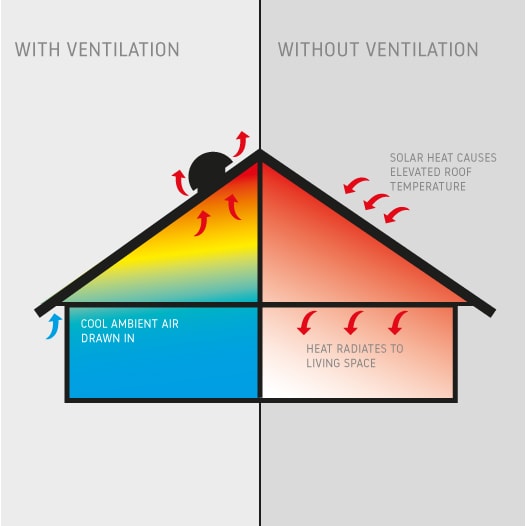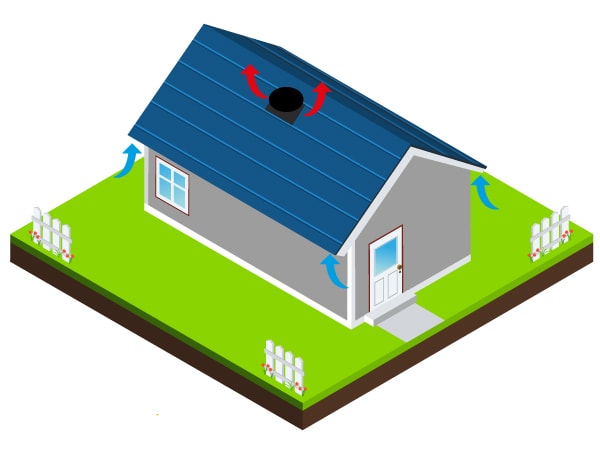Roof Ventilation: What do you need to know
Why should you invest in roof ventilation?
When it comes to keeping homes comfortable, roof ventilation isn’t always the first thing to come to mind. But a well ventilated roof helps maintain a healthy climate throughout the rest of the home. This is particularly evident in Summer when the temperature inside the roof cavity can reach up to 70 degrees Celsius. The heat radiates through the house until someone decides to turn up the air conditioner. This might bring the temperature down but it sends the energy costs soaring. Cooling the roof using ventilation keeps the rest of the home cool and reduces the load on the air conditioner.
Ventilation also combats the build up of moisture and prevents mould growth. Moisture can build up in the roof cavity in a few ways. In Winter, warm air might cause condensation when it rises and gets trapped in the roof. It might also come through an exhaust system somewhere in the house. If you currently have an exhaust fan from the bathroom or kitchen pushing moist air into the ceiling, you need to consider your ventilation requirements. It might even be a good idea to add ducting from exhaust fans to the outside of the building.

How do you put a good roof ventilation system together?
A good ventilation system isn’t too complicated. It consists of vents and a fan. The vents let fresh air in and stale air out. The fan speeds up the process. Universal Fans stocks a range of products for this purpose, including super efficient solar powered fans and mains-powered roof ventilators.
The trick to making sure that your ventilation system works well is putting the fan and vents in the right spots. Install the fan high in the roof because warm air rises. From a high point, the fan will be able to move the warm air.
The out going vents should also be placed high in the roof. The fan draws in fresh air from the lower vents, pushing the warmest air (highest in the roof) out through the high vents. Of course it’s unusual for a roof to have no existing ventilation. It’s important to make a thorough assessment of the existing spaces where air may enter and exit the roof cavity. This includes gaps between tiles and weatherboards.
Place incoming vents low in the roof, ideally in a cool place. Under the eave is a good spot because the air there doesn’t receive direct sunlight, so it’s cooler. Air entering from a cool area will keep the temperature in the roof cavity low.

Summary – Mechanical ventilator at highest point of roof to extract warm air. Passive vents under eaves to allow for fresh (ambient temperature) air to enter the roof space. The combination of both results in a noticeably lower temperature during summer.

Length of Roof x Width of Roof x 1/2 Height of the Roof = m3 roof size
m3 roof size x Air exchange Target (we recommend 10) = total m3/hr volume required
How much ventilation is enough for a roofspace?
As a general guide, you should aim for around 10 air changes per hour in the roof cavity. If there is a lot of moisture built up in your roof, you will need a higher air change rate to fix it. It’s important to choose a fan with the right capacity for the job.
The easiest method to calculate a residential roof cavity size is:
Length of Roof x Width of Roof x 1/2 Height of the Roof
This will provide you with a m3 area. You can then multiply this figure by 10. This is our target number of air changes per hour for adequate roofspace ventilation.
If you still require assistance you can use our online calculator to determine the capacity of the fan you need.
In conjunction with an adequately sized fan extracting the warm air it is also necessary to install passive vents to allow fresh air to enter. As a general guide you should try and find vents that cumulatively allow for the same aperture as the extraction fan. Ideally these vents would be in the lowest part of the roof and well spaced out to allow for even intake of fresh air.
What type of roof ventilation is best?
There are a few different ways to ventilate your roof space. At Universal Fans, we offer both solar and mains powered roof ventilation products. The right choice for you depends on your situation, but either will give you better results than a whirlybird. Generally speaking, it takes more than one whirlybird to cool a roof space effectively. If you’re using a fan with power, you will probably only need one.
Solar Roof fans are incredibly efficient. They move thousands of cubic metres of air per hour so most homes only need one, although a bigger home might need two. They don’t cost anything to run and are also very quiet compared to other options on the market. To give you an idea of how well they work, you need to install around 15 whirlybirds before you get a comparable result. A lot of customers don’t like the look of so many whirlybirds on the roof. They find that a solar fan is a much neater option.
A Mains Powered roof ventilator is another option. In terms of efficiency, they tend to move less air than their solar powered equivalents but they can run overnight. Some models include features like speed controls. Unlike a solar roof fan, they have some running costs associated with them.
Both of these options are more reliable than whirlybirds. Without a decent wind speed, whirlybirds don’t operate at their maximum capacity. Unfortunately, the days without wind are the days when want your fans to work! Imagine a 40 degree day with no breeze. Most Australians have experienced this at some point and know that there’s no relief at all. Now picture how hot your roof space is. You can see that relying on a whirlybird which needs the wind won’t be enough. Using a fan with some kind of power will give you a much better result.
SHOP ROOF VENTILATION FANS SHOP SOLAR ROOF VENTILATION FANS
